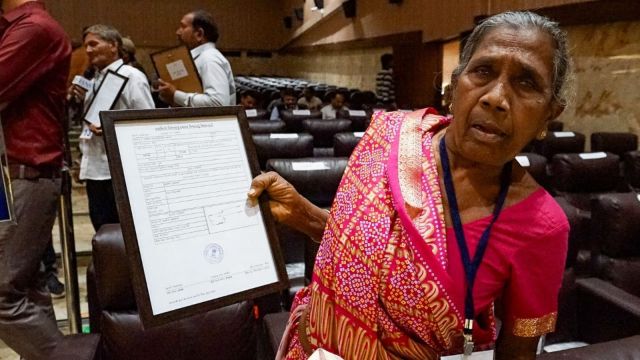A 60-yr-old widow, a woman farmer: Meet Gujarat’s SVAMITVA scheme beneficiaries
Dabhuben was among the 64,029 residents from 415 villages in Gujarat who got the property cards on Saturday at an event presided by Prime Minister Narendra Modi by video conferencing.
 Dabhuben with her certificate on Saturday. (Express/Bhupendra Rana)
Dabhuben with her certificate on Saturday. (Express/Bhupendra Rana)Dabhuben from Timba village near Pirana in Ahmedabad district makes a living by growing paddy and wheat on land she became entitled to after she got married. Over 60 years old now, she lost her husband “about 10-15 years ago” and has no heir, she tells The Indian Express.
“My husband was one among five brothers. The land is in my name and the brothers are all heirs to the property… mara diyaro saara chhe (my brothers-in-law are good people),” she says.
Dabhuben was among the 64,029 residents from 415 villages in Gujarat who got the property cards on Saturday at an event presided by Prime Minister Narendra Modi by video conferencing under the Survey of Villages and Mapping with Improvised Technology in Village Areas (SVAMITVA) scheme. The distribution of cards was done at several locations simultaneously.
From Juna Navapura village of Daskroi taluka in Ahmedabad district, Passiben Ganpatji also got her property card, which, she says “will help me get a loan”. A farmer, she lives with her son and his wife. “Earlier, we would show the receipt of the tax we pay the village panchayat as proof of our land. But now, we have a document,” says Passiben.
In Gujarat, 12.23 lakh property cards have been readied after the promulgation process that was carried out in 7,189 villages.
This process involves inviting objections to the ownership before finally declaring it.
An official from the panchayati raj department told The Indian Express, “The entire process of measuring the land in the gamtal (village land) areas is carried out by the revenue department with the support from the panchayat department.”
The final property card is issued by the District Inspector of Land Records (DILR).
The property cards distributed in Gujarat on Saturday covered 20 districts. CM Bhupendra Patel presided over the Ahmedabad district event even as ministers and MLAs oversaw events held in the rest of the districts.
According to a source from the office of the Settlement Commissioner, the entire process begins from the “chuna marking” of the property, followed by the drone flight and then “ground truthing” after which a map is created. “The creation of the map takes the longest time,” says the officer.
After this, the first notice is served to the owner of the plot and to the public to invite objections. Ten days later, a draft resolution is prepared by the office of the DILR stating the ownership of the property. The DILR then puts out the second notice for 30 days inviting any objection, following which the promulgation of the property is done. “The entire process, per property, could take anywhere from three to four months,” said the official.







